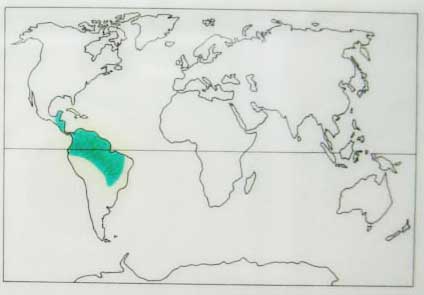
Manacus manacus, Photo: Michael Lahanas
Superregnum: Eukaryota
Cladus: Unikonta
Cladus: Opisthokonta
Cladus: Holozoa
Regnum: Animalia
Subregnum: Eumetazoa
Cladus: Bilateria
Cladus: Nephrozoa
Superphylum: Deuterostomia
Phylum: Chordata
Subphylum: Vertebrata
Infraphylum: Gnathostomata
Megaclassis: Osteichthyes
Cladus: Sarcopterygii
Cladus: Rhipidistia
Cladus: Tetrapodomorpha
Cladus: Eotetrapodiformes
Cladus: Elpistostegalia
Superclassis: Tetrapoda
Cladus: Reptiliomorpha
Cladus: Amniota
Classis: Reptilia
Cladus: Eureptilia
Cladus: Romeriida
Subclassis: Diapsida
Cladus: Sauria
Infraclassis: Archosauromorpha
Cladus: Crurotarsi
Divisio: Archosauria
Cladus: Avemetatarsalia
Cladus: Ornithodira
Subtaxon: Dinosauromorpha
Cladus: Dinosauriformes
Cladus: Dracohors
Cladus: Dinosauria
Cladus: Saurischia
Cladus: Eusaurischia
Subordo: Theropoda
Cladus: Neotheropoda
Cladus: Averostra
Cladus: Tetanurae
Cladus: Avetheropoda
Cladus: Coelurosauria
Cladus: Tyrannoraptora
Cladus: Maniraptoromorpha
Cladus: Maniraptoriformes
Cladus: Maniraptora
Cladus: Pennaraptora
Cladus: Paraves
Cladus: Eumaniraptora
Cladus: Avialae
Infraclassis: Aves
Cladus: Avebrevicauda
Cladus: Pygostylia
Cladus: Ornithothoraces
Cladus: Ornithuromorpha
Cladus: Carinatae
Parvclassis: Neornithes
Cohors: Neognathae
Cladus: Neoaves
Cladus: Telluraves
Cladus: Australaves
Ordo: Passeriformes
Subordo: Tyranni
Infraordo: Tyrannides
Parvordo: Tyrannida
Familia: Pipridae
Genus: Manacus
Species: Manacus manacus
Subspecies: M. m. abditivus – M. m. bangsi – M. m. expectatus – M. m. flaveolus – M. m. gutturosus – M. m. interior – M. m. leucochlamys – M. m. longibarbatus – M. m. manacus – M. m. maximus – M. m. purissimus – M. m. purus – M. m. subpurus – M. m. trinitatis – M. m. umbrosus
Name
Manacus manacus (Linnaeus, 1766)
Type locality: Suriname.
Synonymy
Pipra manacus (protonym)
References
Linnaeus, C. 1766. Systema naturae per regna tria naturae, secundum classes, ordines, genera, species, cum characteribus, differentiis, synonymis, locis (Regnum Animale). Editio duodecima (12th Ed.), reformata. Tomus 1 (Volume 1), Pars 1 (Part 1): 1–532. Holmiæ [Stockholm]. Impensis Direct Laurentii Salvii. p. 340 no. 12 BHL Reference page.
Vernacular names
Deutsch: Weißbrustpipra
English: White-bearded Manakin
español: Saltarín barbiblanco
français: Manakin casse-noisette
Nederlands: Bonte Manakin
português: Rendeira

The white-bearded manakin (Manacus manacus) is a small passerine bird which breeds in tropical South America. It can be found in Colombia, Venezuela and Trinidad south to Bolivia and northern Argentina. This manakin is found in forests, secondary growth and plantations. It is a small, plump bird about 10.7 centimetres (4.2 in) long. Males have a black crown, upper back, wings and tail and are otherwise white. Females are olive-green and resemble female golden-headed manakins. At breeding time, males are involved in lekking behaviour on the forest floor during which they puff out their neck feathers. This is a fairly common species with a wide range, and the International Union for Conservation of Nature has rated its conservation status as being of "least concern".
Description
Like other manakins, the white-bearded manakin is a compact, brightly coloured forest bird, typically 10.7 centimetres (4.2 in) long and weighing 16.5 grams (0.58 oz). The adult male has a black crown, upper back, wings and tail, and the plumage is otherwise white. He has orange legs.
The female and young males are olive-green and resemble female golden-headed manakins, but they have orange legs. The race endemic to Trinidad, M. m. trinitatis is larger than mainland birds, and the female has yellower underparts. Apart from the buzzing display song, the white-bearded manakin has a number of other calls, including a trilled musical peeerr.
Ecology
Female on nest in Brazil
These manakins eat fruit and some insects and spiders.[2]
The male white-bearded manakin has a fascinating breeding display at a communal lek. Each male clears a patch of forest floor to bare earth, and perches on a bare stick. The display consists of rapid leaps between sticks and the ground, accompanied by a loud wing snap, the whirring of the wings, and a chee-poo call. Groups of up to 70 birds may perform together, the largest leks being in Trinidad. The female builds a shallow cup nest low in a tree; two brown-mottled white eggs are laid, and incubated entirely by the female for about 18–19 days, with a further 13–15 days to fledging. The young are fed mainly on regurgitated fruit with some insects.
Distribution
In South America, two thirds of white-bearded manakin's range is in the combined Amazon Basin, the Guianas, and the Orinoco River drainage of Venezuela; also eastern Colombia. Three disjunct populations occur: Pacific coastal Ecuador, with southwestern Colombia; coastal and inland western Venezuela with northwestern Colombia; and the largest, southeastern Brazil, with inland regions bordering Paraguay in the south, and from Paraná state to coastal Pernambuco in the northeast.
Only one area of the Amazon Basin does not have the species, the 2200 km Purus River region in southwestern Amazonas state.
Status
This bird has a very wide range, is fairly common and is presumed to have a large total population. The population trend is thought to be stable and the International Union for Conservation of Nature has rated the bird's conservation status as being of "least concern".[1]
References
BirdLife International (2016). "Manacus manacus". IUCN Red List of Threatened Species. 2016: e.T22701112A93813825. doi:10.2305/IUCN.UK.2016-3.RLTS.T22701112A93813825.en. Retrieved 12 November 2021.
Tu, Lindsey; McCabe, Casey; Tori, Wendy (2020). "White-bearded Manakin (Manacus manacus), version 1.0". Birds of the World. doi:10.2173/bow.whbman1.01.
Hilty, Steven L (2003). Birds of Venezuela. London: Christopher Helm. ISBN 0-7136-6418-5.
ffrench, Richard (1991). A Guide to the Birds of Trinidad and Tobago (2nd ed.). Comstock Publishing. ISBN 0-8014-9792-2.
Retrieved from "http://en.wikipedia.org/"
All text is available under the terms of the GNU Free Documentation License

